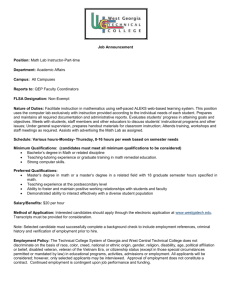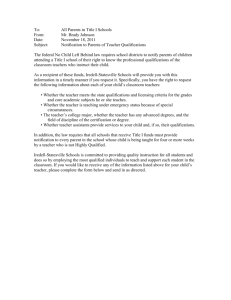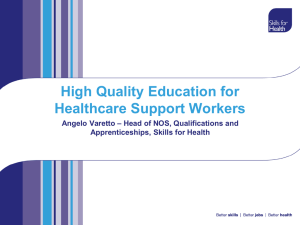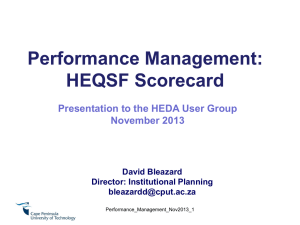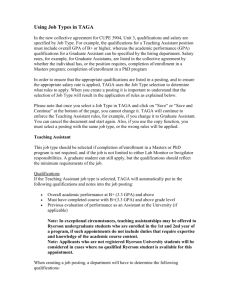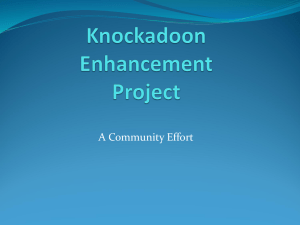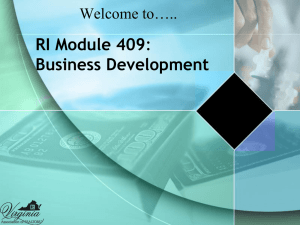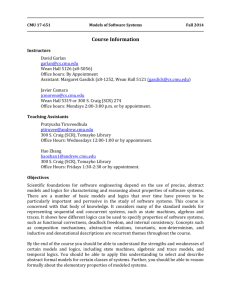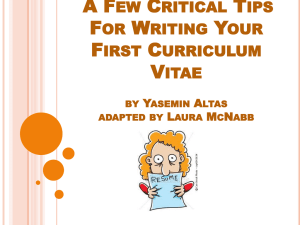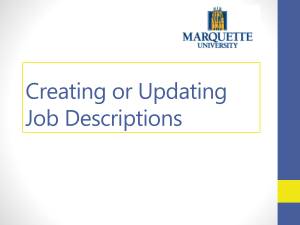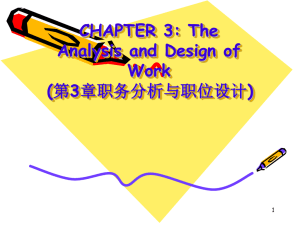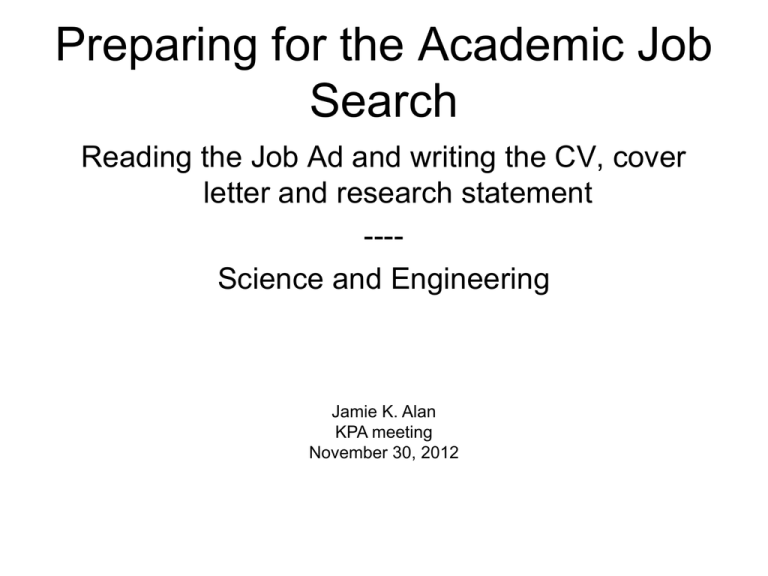
Preparing for the Academic Job
Search
Reading the Job Ad and writing the CV, cover
letter and research statement
---Science and Engineering
Jamie K. Alan
KPA meeting
November 30, 2012
Where do you find jobs?
• Online, in science
(http://sciencecareers.sciencemag.org),
National postdoc association, chronicles of
higher education, higher ed jobs, on
individual universities’ websites
• Job search engines-Academic Keys,
LinkedIn, etc
• NETWORK!
How to apply
• Usually, you need to include a CV, cover
letter, statement of research and
statement of teaching philosophy (min
requirements)
• The job ad will usually give instructions
regarding the application process
• The majority of this is done online.
From a position announcement for
an Assistant Professor:
• Applicants should send a detailed
curriculum vitae, a statement of their
interest in teaching and planned
research and the names of at least three
references.
Career Services, University of
Pennsylvania
From a position announcement for
an Assistant Professor:
• Applicants should submit a letter of
application, a curriculum vita, a statement
of research plan and teaching interests,
and a list of at least three references to:
Career Services, University of
Pennsylvania
From a position announcement for
an Assistant Professor:
• Application packet must include: 1)
curriculum vita, including a list of
publications, 2) complete set of official
transcripts, 3) statement of teaching
experience, interests and philosophy, 4)
statement of research interests and
plans, and 5) at least three letters of
reference.
Career Services, University of
Pennsylvania
From a position announcement for
a Tenure-Track Professor:
• Applicants should include in their response
a clear statement of their teaching and
research interests, a curriculum vitae
summarizing their educational and
professional backgrounds together with a
list of published works, and the names of
at least four persons who may be
contacted regarding the candidate's
qualifications
Career Services, University of
Pennsylvania
Sample Job Ad
•
•
•
•
•
•
•
•
•
•
•
•
•
•
•
•
•
•
•
•
•
Position Title (Discipline and Rank)
Basic Science Faculty (12 month, Assistant/Associate/Full Professor)
Home Department
Medicine, College of
Employee Group
Click the link to view eligible benefits.
Regular Faculty - 12 month
Staff Pay Level:
Starting Salary
N/A
Employment Status
No Response
Position Type
12 month
Position Begin Date:
Position End Date (if applicable)
Type of Recruitment
Definition of Internal
External
Sample Job Ad-2
•
•
Position Summary:
The Central Michigan University College of Medicine (CMED) is seeking highly
qualified faculty for multiple tenure-track and fixed term positions in the basic science
discipline. Successful candidates will assume a role in the development and
implementation of a highly integrated, cross disciplinary, clinical presentation and
inquiry-based medical school curriculum. Additional duties will include classroom
teaching, sustained scholarly activity, serving as course director, and committee
service. -want people who will spend time in the classroom, but also people who are
leaders and in charge.
•
Positions will be at Assistant/Associate/Full Professor rank, depending on credentials,
and are available immediately. Start dates are negotiable. Applications are being
sought for teaching expertise in all disciplines of the basic sciences with immediate
needs in Anatomy, Pharmacology, and Microbiology.
•
•
Required Qualifications
Doctoral degree, strong commitment to innovative approaches to education and
learning, ability or commitment to facilitate interactive learning in large and small
group settings; experience with independent design and conduct of research
consistent with discipline(s);
–
–
–
strong collaborative and communication skills;
and a demonstrated commitment to diversity.
Wrote you own fellowship applications, developed own projects.
Sample Job Ad-3
•
•
•
•
•
•
•
•
Preferred Qualifications:
Teaching - experience with cross disciplinary teaching;
documented experience in patient and/or problem-based medical education;
experience with, or a strong knowledge of, pedagogical approaches such as team
based learning.
Research - while all areas of research will be considered, collaborative opportunities
in basic research exist in neuroscience, mitochondrial biology, and cancer vaccines.
Additional desired areas of research include: education, comparative effectiveness,
health services, and clinical trials and outcomes.
Required Documents to Attach
–
–
–
–
–
–
•
Resume/CV
Letter of Interest
Evidence of Teaching Effectiveness
Statement of Teaching Philosophy
Statement of Research
List of References
Optional Documents to Attach
–
Other Document
Sample Job Ad-4
•
•
•
•
•
•
•
•
Posting Begins
02-20-2012
Posting Ends
Open Until Filled
Message to Applicants
Review of applications begins immediately and continues until filled. Electronically
attach a letter of application, curriculum vitae, evidence of teaching ability, statement
of teaching philosophy, statement of research/scholarly interest, and a list of three
professional references, including phone numbers and email addresses. Questions
can be directed to Rebecca Messing, Search Committee Coordinator,
Spenc1rl@cmich.edu, 989-774-7862.
About the Department:
The CMU College of Medicine will welcome its inaugural class in the summer of
2013. The innovative medical school curriculum is being designed to prepare
students for practice in mid- to northern Michigan and the Upper Peninsula, with
particular attention to primary care needs in the region. The program is housed in a
new facility with advanced technology for teaching. For more information, visit
www.cmich.edu/med.
Sample Job Ad-5
•
•
•
•
About CMU
Established in 1892, Central Michigan University is one of the nation's 100 largest
public universities and the fourth largest in Michigan, with more than 21,000 students
on its Mount Pleasant campus and another 7,000 enrolled online and at more than 60
locations throughout the United States, Canada and Mexico. CMU offers more than
200 academic programs at the undergraduate, master's, specialist and doctoral
levels, including nationally recognized programs in entrepreneurship, journalism,
music, audiology, teacher education, psychology and physician assistant. CMU also
has established a College of Medicine, anticipated to open in 2013.
EEO Statement
CMU, an AA/EO institution, strongly and actively strives to increase diversity and
provide equal opportunity within its community. CMU does not discriminate in
employment against persons based on age, color, disability, gender, gender
identity/gender expression, genetic information, familial status, height, marital status,
national origin, political persuasion, race, religion, sex, sexual orientation, veteran
status, or weight (see http://www.cmich.edu/aaeo.)
Writing a cover letter
From the chronicles of higher education: “Most applicants
write poor cover letters that bear no relationship to what
goes on in a particular department or school. They are
word-processed form letters, and search committees can
spot them right away.”
Take your time and tailor!
“Find out enough about the college to which you are
applying to show the connection between what you have
to sell and what the college wants to buy.”
Most guides say 1 page, however up to 2 pages is
acceptable if all the content is relevant.
Writing a cover letter
Parts of a cover letter
• Salutation- Be formal (Dr., Professor, etc) and specific
Make sure the spell the name(s) correctly and use the
correct salutation!
• Body- should consist of one or two paragraphs that
highlight your interest in the position, your strongest
attributes and your strong qualifications. Use this
opportunity to elaborate upon the distinctive strengths
and qualifications you would bring to the position and
attempt to persuade the search committee that you are a
highly qualified candidate deserving additional
consideration.
• Modesty is not rewarded in the job search, and you may
be the only voice articulating your qualifications to the
search committee.
Writing a cover letter
Parts of a cover letter
• Specifics- If you are applying to a research institute,
highlight why you are qualified. Similarly, if you are
applying to a teaching institute, highlight your teaching
experience.
• Address any other requirements that the job posting
requests, as well as any other qualifications or
experiences that you possess. If any information on your
CV is confusing or may cause questions among the
search committee, address these topics in the cover
letter.
• Conclusion- reinforce your interest in the position and in
obtaining an interview. Indicate the other materials you
are enclosing in your application packet and whether any
other materials are being sent under separate cover.
CV Writing
• 1. Education. Always. No exceptions. List by degree,
not by institution. Give department, institution, and year
of completion.
• 2. Professional Appointments/Employment. This must
go immediately under education, assuming that you
have/had these. These are contract positions only–
tenure track or adjunct. Postdoctoral positions also go
here. Give institution, department, title, and dates (year
only) of employment.
• 3. Publications. Subheadings: Books, Edited Volumes,
Refereed Journal Articles, Book Chapters, Conference
Proceedings, Book Reviews, Manuscripts in Submission
(give journal title), Manuscripts in Preparation, WebBased Publications, Other Publications (this section can
include non-academic publications, within reason).
CV Writing
• 4. Awards and Honors. Give name of award and
institutional location.
• 5. Grants and Fellowships (if you are in a field where
these differ categorically from Awards and Honors). Give
funder, institutional location in which received/utilized,
year span.
• 6. Invited Talks. Give title, institutional location, and
date. Year only.
• 7. Conference Activity/Participation. Name of paper,
name of conference, date. Year (Year only) on left as
noted above. Month and date-range of conference in the
entry itself (ie, March 22-25).
CV Writing
• 8. Teaching Experience. Subdivide either by area/field
of teaching or by institutional location, or by
Graduate/Undergraduate, or some combination of these
as appropriate to your particular case
• 9. Research Experience. RA experience goes here, as
well as lab experience. This is one location where slight
elaboration is possible, if the research was a team effort
on a complex, multi-year theme. One detailed sentence
should suffice.
• 10. Service To Profession. Include journal manuscript
review work (with journal titles), leadership of
professional organizations, etc. Some people put panel
organizing under service; check conventions in your
field.
CV Writing
• 11. Departmental/University Service. Include search
committees and other committee work, appointments to
Faculty Senate, etc.
• 12. Related Professional Skills. [Optional.] Can
include training in GIS and other technical skills relevant
to the discipline.
• 13. Non-Academic Work. [Optional—VERY optional!]
Include only if relevant to your overall academic
qualifications.
• 14. Languages.
• 15. Professional Memberships/Affiliations. All
professional organizations of which you are a member
listed vertically.
• 26. References. Usually these are provided in a
separate document
Purpose of Research Statement
or Research Summary
It is expected that you will have begun to think coherently
about research beyond your dissertation and/or postdoc
work.
• The research statement tells
– what you have been doing recently and currently,
– in what direction you hope to go,
– how your research contributes to your field.
• Along with your CV, cover letter and letters of
recommendation, it helps hiring committees assess your
– areas of specialty,
– potential to get grants,
– academic ability,
– compatibility with the department or school.
Writing the Research Statement
• Give a context for your research interests
– Why does it matter?
• Communicate a sense that your research
will follow logically from what you have
done and that it will be different, important,
and innovative
• Communicate that these projects are
yours and your mentor has given you
permission to take them with you.
Career Services, University of
Pensylvania
Parts of the Research Statement
• A "Research Summary" combines features
of both the statement of achievements and
current work, and the proposal for
upcoming research because it includes
current aims and findings AND future
goals.
Career Services, University of
Pennsylvania
Future Goals or Research Plans
Include:
• Major problem(s) you wish to attack.
• The problem’s relevance to the field.
• Your specific goals for a 3-5 year period, including
potential outcomes.
• If you know what a particular funding agency funds, you
can name the agency and briefly outline a proposal.
This might convince the reader that you are on the way
to getting a project funded.
• At the same time, you should have research goals that
have broad enough goals so that if one topic doesn't get
funded there are other areas on which you can work.
How to Make it Effective -- Format
• Use headings (and subheadings), bullets,
and white space.
• Avoid page-long paragraphs.
• It should be1-2 pages long; 3 pages at the
most.
• Get feedback.
• Proofread!!!
How to Make it Effective -- Content
• Write as clearly and concisely as you can.
• What excites you about your research? Sound
fresh.
• Where appropriate, acknowledge the work of
others.
• Use language that shows you’ve begun to think
of yourself as an independent researcher
• If you've identified funding organizations likely to
support your research plans, indicate that.
• Tailor tailor tailor!!!!
Preparing for the Interview
• Consider preparing a longer version (5-15
pages) to bring along to the on site interview.
[Check with your advisor to see if this is
necessary.]
• Candidates may be asked to describe research
plans and budget in detail at the campus
interview. Be prepared.
• Include laboratory needs (how much budget you
need for equipment, how many grad assistants
needed, etc.) to start up the research.
Career Services, University of
Pennsylvania
General Tips
• Have a discussion with your mentor. Mention your plans
and hash out what you can and cannot take with you
• PROOFREAD! This is very important!
• Have others read you application packet, preferable
someone familiar w/ that sort of position.
• If you struggle with English, get a native English speaker
to edit you packet.
• Read the job ad very carefully. Literally check off the
parts you have addressed.

